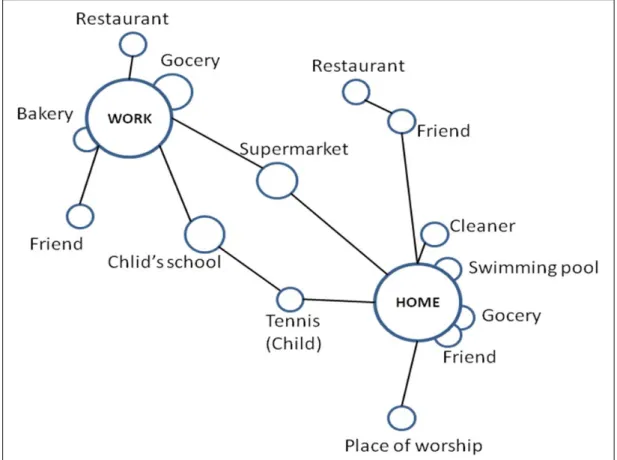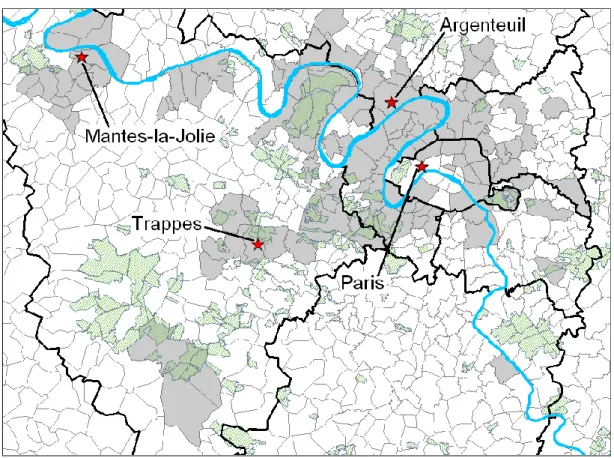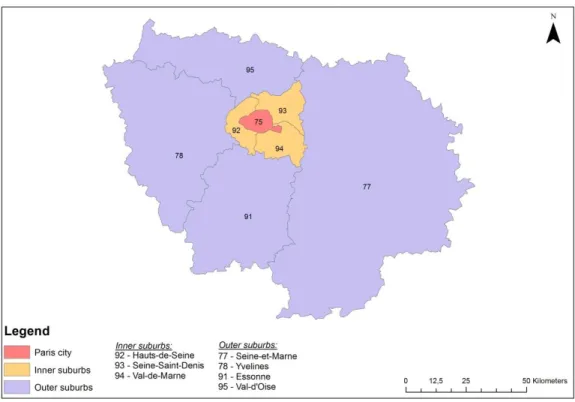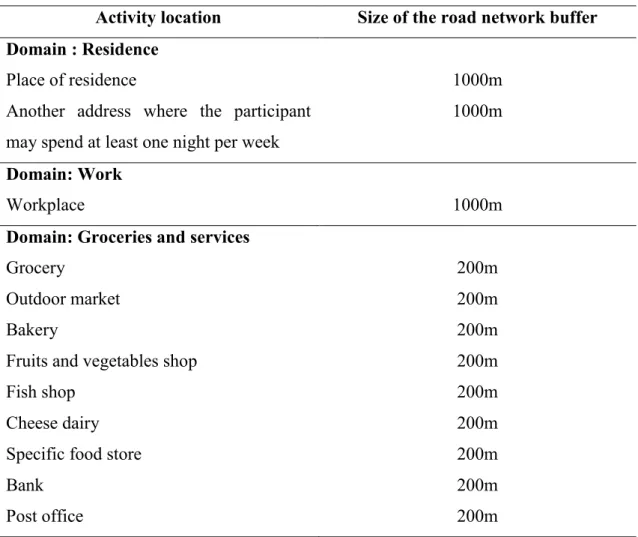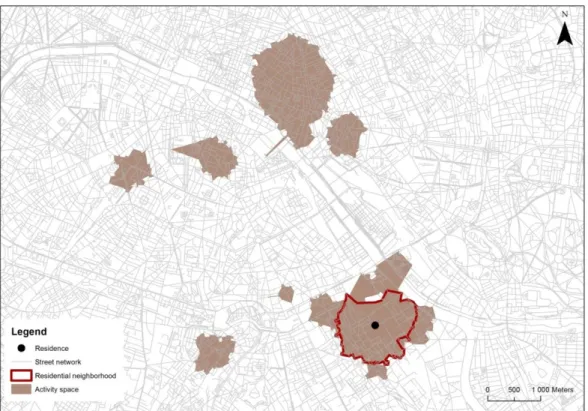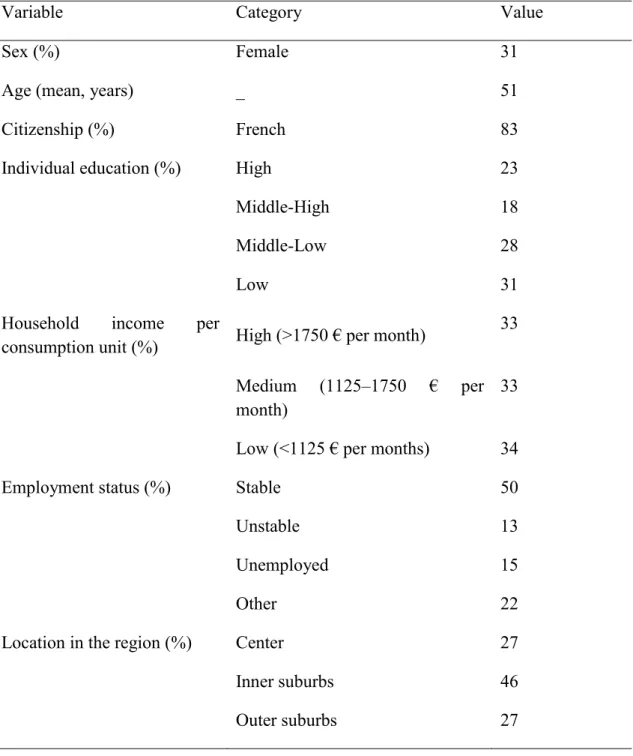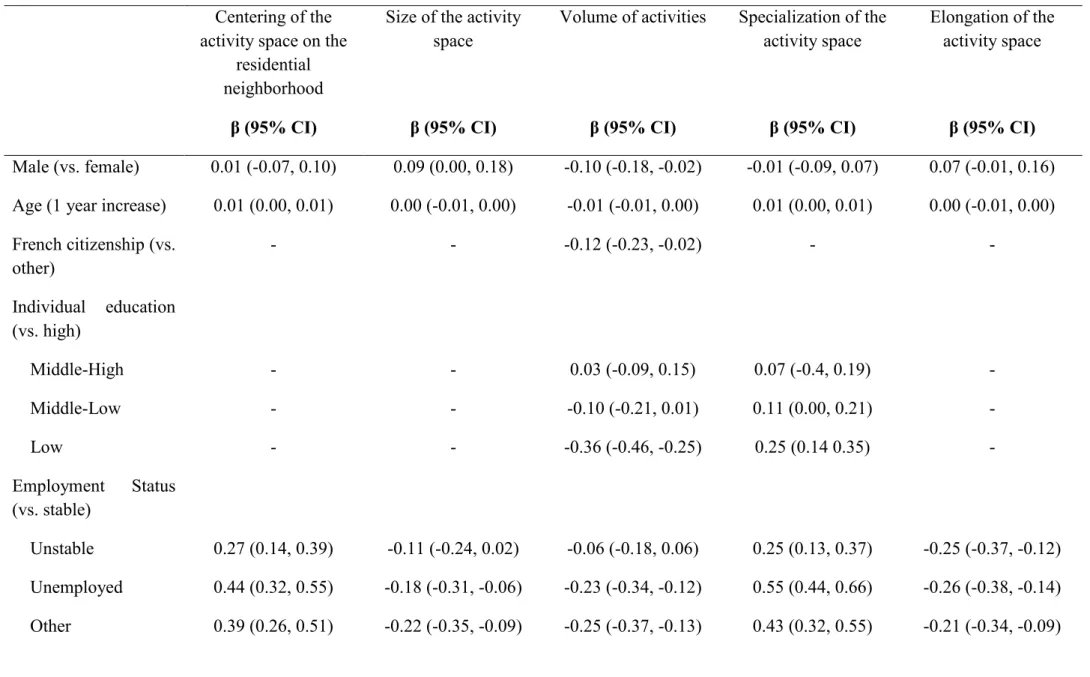HAL Id: tel-01334568
https://tel.archives-ouvertes.fr/tel-01334568
Submitted on 21 Jun 2016HAL is a multi-disciplinary open access archive for the deposit and dissemination of sci-entific research documents, whether they are pub-lished or not. The documents may come from teaching and research institutions in France or abroad, or from public or private research centers.
L’archive ouverte pluridisciplinaire HAL, est destinée au dépôt et à la diffusion de documents scientifiques de niveau recherche, publiés ou non, émanant des établissements d’enseignement et de recherche français ou étrangers, des laboratoires publics ou privés.
Accounting for residential and non-residential
environments to measure contextual effects on health
behavior : the case of recreational walking behavior
Camille Perchoux
To cite this version:
Camille Perchoux. Accounting for residential and non-residential environments to measure contextual effects on health behavior : the case of recreational walking behavior. Santé publique et épidémiologie. Université Pierre et Marie Curie - Paris VI; Université de Montréal. Ecole de santé publique, 2015. English. �NNT : 2015PA066593�. �tel-01334568�
THÈSE DE DOCTORAT DE L’UNIVERSITÉ PIERRE ET MARIE CURIE ET DE L’UNIVERSITÉ DE MONTRÉAL
Spécialité : Epidémiologie
Accounting for residential and non-residential environments to measure contextual effects on health behavior: The case of recreational walking behavior
par
Camille Perchoux
École Doctorale 393 Pierre Louis de Santé Publique - Épidémiologie et Sciences de l’Information Biomédicale, Université Pierre et Marie Curie - Paris 06 Département de Médecine Sociale et Préventive, École de Santé Publique de
l’Université de Montréal
Présentée et soutenue publiquement le 15 juin 2015 Devant un jury composé de :
Yan KESTENS Chargé de Recherche Directeur de thèse Basile CHAIX Chargé de Recherche Co-Directeur de thèse Anthony GATRELL Chargé de Recherche Rapporteur
Maria Victoria ZUNZUNEGUI Chargée de Recherche Rapporteur Isabella ANNESI-MAESANO Chargée de Recherche Examinatrice Pierre-Yves Boëlle Chargé de Recherche Examinateur Sophie LAFOREST Chargée de Recherche Examinatrice
Sorbonne Universités - UPMC Université Paris 06
École doctorale 393 Pierre Louis de Santé Publique – Épidémiologie et Sciences de l’Information Biomédicale
Université de Montréal
Faculté des études supérieures et postdoctorales
Thèse en cotutelle présentée à l’École de santé publique de l’Université de Montréal en vue de l’obtention
du grade de Philosophiae Doctor (PhD)
en Santé publique option Épidémiologie (Université de Montréal) et
i
RESUME
Contexte : Les études portant sur les effets de l’environnement sur la santé ont
essentiellement examiné les effets de l’environnement résidentiel. Cette approche a été critiquée pour son absence de prise en compte des environnements géographiques de vie non-résidentiels (c.-à-d. le travail, l’école, les lieux récréatifs et sociaux, etc.). Alors que la mobilité est un déterminant clé de l’exposition, peu d’études ont examiné les mobilités quotidiennes pour évaluer les effets du milieu sur la santé.
Objectifs : L’objectif général de cette thèse est d’évaluer si la prise en compte des
lieux d’activité dans lesquels les individus se déplacent et sont régulièrement exposés permet de mieux estimer l’impact de l’environnement sur la pratique de la marche récréative. Les objectifs spécifiques de la thèse sont : i) identifier les différents types de comportement spatiaux des individus vivants en région Île-de-France et leurs déterminants sociodémographiques ; ii) évaluer si l’exposition à des facteurs environnementaux facilitant la marche diffère en fonction de la définition géographique de la zone d’exposition et varie en fonction du niveau socio-économique et de la localisation de la résidence dans la région Île-de-France ; iii) évaluer les caractéristiques environnementales, résidentielles et non-résidentielles, associées à la pratique de la marche récréative.
Méthodes : Trois études transversales ont été conduites sur la seconde vague de la
Cohorte RECORD (Residential Environment and CORonary heart Disease). Les lieux d’activité réguliers des participants, ainsi que la délimitation de leur quartier résidentiel perçu ont été collectés grâce à l’application VERITAS (Visualization and Evaluation of Regular Individual Travel destinations and Activity Spaces).
Résultats : La première étude a permis d’identifier une typologie des comportements
de mobilité individuels caractérisés par : i) la taille de l’espace d’activité, ii) l’élongation de l’espace d’activité, iii) le centrage de l’espace d’activité sur le quartier
ii
de résidence, iv) le volume d’activités, et v) les types d’activités réalisées. Le statut socio-économique et la localisation de la résidence dans l’agglomération parisienne sont apparus comme de forts déterminants du comportement spatial. Les résultats de la deuxième étude montrent que l’exposition à des caractéristiques environnementales facilitant la marche diffère entre le quartier de résidence, le quartier résidentiel perçu, et l’espace d’activité. L’erreur de mesure liée à la seule prise en compte de mesures d’exposition résidentielle varie en fonction des groupes socio-économiques et des degrés d’urbanisation de la résidence dans la région Île-de-France. Dans la troisième étude, une densité de destinations élevée, la présence de lacs ou de voies d’eau et un niveau d’éducation élevé du quartier sont associés à une augmentation de la pratique de la marche récréative. Enfin, cette étude montre une forte influence des caractéristiques environnementales autour de la résidence et des lieux d’activité récréatifs sur la pratique de la marche récréative.
Conclusion : Cette thèse souligne l’importance de prendre en compte les
environnements géographiques de vie résidentiels et non-résidentiels pour i) mieux approximer l’exposition environnementale réelle, ii) évaluer les effets de l’environnement sur les comportements de santé. Afin d’approfondir les mécanismes par lesquels l’environnement influence la pratique de l’activité physique, il apparait pertinent d’examiner conjointement où les individus se déplacent, mais également ce
que les individus font, en termes de types d’activité et de contraintes liées aux
activités réalisées. Identifier quels lieux d’activité ont le plus d’influence sur la pratique de l’activité physique contribue à cibler des contextes géographiques prioritaires pour les interventions en promotion de la santé.
Mots clés : Mobilités quotidiennes, Espace d’activité, Activité physique, Quartier
iii
SUMMARY
Background: Previous studies on place effect on health focused on the residential
neighborhood. This approach was criticized for not considering non-residential geographic life environments. While mobility is a key determinant of exposure, few studies accounted for daily mobility to evaluate environmental effects on health.
Purpose: The overarching aim of this dissertation is to estimate whether accounting
for people’s network of activity places and their resulting exposure allows improving the understanding of environmental influences on recreational walking behavior. The specific objectives are: i) to identify types of spatial behavior of individuals living in the Ile-de-France region and their socio-demographic correlates; ii) to assess whether the exposure to supportive walking environments differs depending on the geographic definition of the exposure area and varies by the socioeconomic status and the degree of urbanicity; iii) to evaluate which residential and non-residential neighborhood characteristics are associated with recreational walking.
Methods: Three cross sectional studies were conducted on the second wave of the
RECORD Cohort Study (Residential Environment and CORonary heart Disease). Information on participants’ regular activity places and perceived residential neighborhood were collected through the VERITAS application (Visualization and Evaluation of Regular Individual Travel destinations and Activity Spaces).
Result: In the first study, I identified a typology of individuals’ patterns of mobility
characterized by: i) the size of the activity space, ii) the elongation of the activity space, iii) the centering of the activity space on the residential neighborhood, iv) the volume of activity, and v) the type of activity performed. The individual-level socio-economic status and degree of urbanicity of the place of residence in the Ile-de-France region are strong determinants of individuals’ spatial behavior. Results from the second study provide evidence that exposure to environmental characteristics
iv
supportive to walking highly differs between the residential neighborhood, the perceived residential neighborhood and the activity space. The measurement error resulting from the sole use of residential measures of exposure varies among SES groups and among categories of the degree of urbanicity of the residence. In the third empirical study a high density of destinations, the presence of a lake or waterway, and a high neighborhood education are associated with recreational walking. Finally, this study provides evidence of a strong influence of the environmental condition around the home and the recreational activity locations on the practice of recreational walking.
Conclusion: This dissertation strengthen the conceptual grounds and empirical
evidence that accounting for both residential and non-residential geographical environments individual get exposed is required to i) better proxy the true environmental exposure, ii) estimate environmental influences on health behaviors. In order to investigate the mechanisms through which environmental exposure influence physical activity, it is relevant to examine where people go, and what people actually
do in terms of type of activity and constraints related to the activity performed.
Identifying which activity places is most influential on physical activity informs on the geographical contexts health promotion interventions should target.
Keywords: Daily mobility, Activity space, Physical activity, Residential trap,
v
TABLE OF CONTENTS
Resume ... i Summary ... iii Table of contents ... v List of tables ... xList of figures ... xii
List of abbreviations ... xiv
Acknowledgements ... xvi
CHAPTER 1. INTRODUCTION ... 1
1.1 Environment and disease causation: eras and paradigms ... 3
1.2 Back to the future in environment and health studies: moving beyond a residential-based perspective in exposure measurement toward the inclusion of multiple contexts ... 5
1.3 Two major reasons to account for mobility in health studies ... 8
1.4 Assessing individuals’ spatial behaviors in health studies: the concept of activity space ... 10
1.5 Accounting for daily mobility in exposure assessment ... 11
1.6 But beware of the selective daily mobility bias ... 12
1.7 Dissertation form ... 13
CHAPTER 2. LITERATURE REVIEW ... 15
2.1 Article 1: conceptualization and measurement of environmental exposure in epidemiology: accounting for activity space related to daily mobility ... 17
2.1.1 Abstract ... 19
vi
2.1.3 Measuring exposure: the limits of a static approach to neighborhood ... 21
2.1.4 Considering mobility in exposure assessment: relevance of the concept of activity space ... 26
2.1.5 Conclusion ... 37
2.1.6 References ... 39
2.1.7 Tables and figures ... 51
2.2 An empirical case study: recreational walking behavior ... 52
2.2.1 Definition of physical activity and recreational walking ... 52
2.2.2 Prevalence and patterns of recreational walking ... 53
2.2.3 Correlates of recreational walking ... 54
2.2.4 Addressing Limitations of Past Research ... 56
CHAPTER 3. SUMMARY AND OBJECTIVES ... 59
3.1 Summary and general objective... 61
3.2 Specific objectives ... 62
3.2.1 To identify types of spatial behavior of individuals living in the Paris metropolitan area and their socio-demographic correlates ... 62
3.2.2 To assess whether exposure to hypothesized supportive walking environments differs between the residential neighborhood, perceived residential neighborhood and activity space by socio-economic status and degree of urbanicity ... 63
3.2.3 To evaluate which residential and non-residential neighborhood characteristics are associated with recreational walking ... 64
CHAPTER 4. METHODS... 65 4.1 Design ... 67 4.2 Participants ... 69 4.3 Procedures... 70 4.4 Measures ... 71 4.4.1 Dependent variable ... 71 4.4.2 Environmental variables ... 72
vii
4.4.3 Individual variables... 72
4.4.4 Creating residential and activity space exposure areas ... 77
4.5 Analyses ... 81
4.5.1 Objective 1 ... 81
4.5.2 Objective 2 ... 82
4.5.3 Objective 3 ... 83
CHAPTER 5. RESULTS ... 85
5.1 Article 2: assessing patterns of spatial behavior in health studies: their socio-demographic determinants and associations with transportation modes (the record cohort study) ... 87
5.1.1 Abstract ... 89
5.1.2 Introduction ... 91
5.1.3 Materials and methods ... 93
5.1.4 Results ... 97
5.1.5 Discussion ... 101
5.1.6 Conclusion ... 106
5.1.7 References ... 108
5.1.8 Tables and figures ... 115
5.2 Article 3: residential neighborhood, perceived neighborhood, and individual activity space: quantifying differences in built environment exposure - the record cohort study ... 129
5.2.1 Abstract ... 132 5.2.2 Introduction ... 133 5.2.3 Methods ... 135 5.2.4 Results ... 138 5.2.5 Discussion ... 141 5.2.6 Conclusion ... 143 5.2.7 References ... 146
5.2.8 Tables and figures ... 151
viii
5.3 Article 4: accounting for the multiple daily activity places of people in the study of the built environment correlates of recreational walking (the
record cohort study) ... 161
5.3.1 Abstract ... 164
5.3.2 Introduction ... 165
5.3.3 Material and methods ... 166
5.3.4 Results ... 171
5.3.5 Discussion ... 173
5.3.6 Conclusion ... 176
5.3.7 References ... 177
5.3.8 Tables and figures ... 186
CHAPTER 6. DISCUSSION AND CONCLUSION ... 193
6.1 Summary of results ... 195
6.2 Connections with the current literature ... 197
6.3 Contributions ... 199
6.3.1 Definition and operationalization of the activity space ... 199
6.3.2 An attempt to address the selective daily mobility bias ... 202
6.3.3 Does accounting for activity places improve our understanding of place effects on health behavior? ... 204
6.3.4 Implications for Public health and related interventions ... 206
6.4 Strengths and limitations ... 207
6.5 Future directions and recommendations ... 211
6.6 Conclusion ... 214
REFERENCES ... 215
Cited in the manuscript ... 217
Cited in the articles ... 245
APPENDICES ... xix
Appendix I: RECORD consent form ... xxi
ix
Appendix III. Characteristic of environmental variables as possible correlates of recreational walking ... xxxi Appendix IV. Résumé étendu ... xxxii Appendix V. Curriculum vitae ... xlviii
x
LIST OF TABLES
Chapter 4. Methods
Table 1. Types of activity places geolocated in VERITAS and related buffer seize for
environmental data extraction ... 78
Chapter 5. Results - Article 2
Table 1. Spatial and behavioral indicators considered for the typology of spatial
behavior... 116
Table 2. Selected characteristics of the RECORD participants included in the present
study (n=2062) ... 119
Table 3. Factor analysis of indicators of spatial behavior, VERITAS-RECORD data
(n=2062) ... 120
Table 4. Associations between individual socio-demographic characteristics and the
different components of spatial behavior (n=2062) ... 122
Table 5. Average weekly number of days (standard deviations) of use of
transportation modes according to the components of spatial behavior divided in three categories (n=2062) ... 125
Chapter 5. Results - Article 3
Table 1. Glossary of technical expressions ... 151 Table 2. Types of activity places and related sizes of the buffer for assessing
environmental exposures ... 153
Table 3. Means and standard deviations of environmental exposures in the exposure
areas by income and urbanicity degree (n=4383a) ... 154
Table 4. Differences in environmental exposure between the exposure areas by
xi
Table S1. Analysis of variance between individual/environmental characteristics and
size of the exposure areas in km2 (n=4383a) ... 160 Chapter 5. Results - Article 4
Table 1. Descriptive information on the sample used in the study based on the
RECORD Cohort, Paris Metropolitan Area, 2011–2013. ... 188
Table 2. Size (SD) of the exposure areas sequentially incorporating additional activity
locations. ... 189
Table 3. Association between individual and environmental characteristics and not
reporting any recreational walking (zero inflation part), the RECORD Study, 2011-2013. ... 190
Table 4. Association between individual and environmental characteristics and the
recreational walking time among walkers (count part), the RECORD Study, 2011-2013. ... 192
xii
LIST OF FIGURES
Chapter 1. Introduction
Figure 1. Chaix et al.’s (2012) theoretical illustration of the environment, mobility
and health triad ... 8
Chapter 2. Litterature review - Article 1
Figure 1. Schematic activity space representation with nodes and links (inspired
from Flamm and Kaufmann 2006) ... 51
Chapter 4. Methods
Figure 1. Location of the 112 municipalities selected in the RECORD Cohort Study
and the 4 health care centers where participants had a check-up ... 69
Figure 2. Paris city and suburbs ... 75 Figure 3. Residence and regular activity locations of 4386 participants from the
RECORD Cohort Study ... 77
Figure 4. Representation of the residential neighborhood and the activity space of
one participant living in the inner suburbs from the RECORD Cohort Study ... 80
Figure 5. Representation of the full and truncated activity space ... 81 Chapter 5. Results - Article 2
Figure 1. Examples of indicators of spatial behavior... 127 Chapter 5. Results - Article 3
Figure 1. Graphical representation of the SRB, PRN and activity space of two
participants of the RECORD Cohort residing respectively in the city center and in the outer suburb ... 157
xiii
Figure 2. Mean density of green spaces according to household income ... 158 Chapter 5. Results - Article 4
Figure 1. Representation of the different portions of an individual’s activity space
xiv
LIST OF ABBREVIATIONS
AIC Akaike Information Criterion
CIHR Canadian Institutes of Health Research
CNIL Commission nationale de l'informatique et des libertés
National Commission for Data Protection and Liberties
GIS Geographic Information System
IAU - IDF Institut d’Aménagement et d’Urbanisme d’Ile- de-France
Institute of Urban Planning of region Ile-de-France
ICC Intraclass Correlation Coefficient
IGN Institut national de l'information géographique et forestière
National Geographic Institute
INSEE Institut National de la statistique et des études économiques
National Institute of Statistics and Economic Studies
INSERM Institut National de la Santé et de la Recherche Médicale
National Institute of Health and Medical Research
IPC Centre d'Investigations Préventives et Cliniques
PRN Perceived Residential Neighborhood
RECORD Residential Environment and CORonary heart Disease
SES Socio-economic Status
SRB Street Residential Buffer
VERITAS Visualization and Evaluation of Regular Individual Travel destinations and Activity Spaces
xv
À mes parents, qui m’ont soutenue et encouragée tout au long de mon doctorat.
xvi
ACKNOWLEDGEMENTS
Si ce doctorat s’est révélé être une véritable expérience de vie, c’est avant tout grâce aux nombreuses personnes qui m’ont guidée et encouragée en tout temps, d’un bout à l’autre de l’Atlantique.
Tout d’abord, je souhaite remercier vivement mes directeurs de thèse Yan et Basile, pour toute la confiance, le soutien et l’aide qu’ils m’ont offert au cours de ces années de doctorat. Merci également pour votre esprit critique et l’exigence dont vous avez fait part au quotidien qui m’ont permis de me dépasser. Merci enfin d’avoir rendu possible cette aventure et de m’avoir permis non seulement de travailler sur un sujet qui m’a passionnée, mais également d’adopter une posture interdisciplinaire, mêlant épidémiologie et géographie qui m’est extrêmement chère.
Je remercie sincèrement les membres du jury de me faire l’honneur de consacrer leur temps précieux à la lecture et l’évaluation de ce manuscrit.
Je remercie Dominique Costagliola, directrice de l’école doctorale 393 et directrice de l’unité INSERM Umr s1136, ainsi que Pierre Chauvin, responsable d’équipe au sein de cette unité, de m’avoir accueillie et d’avoir assuré les conditions matérielles et logistiques favorables au bon déroulement de ce doctorat.
Je tiens à remercier vivement les partenaires et les protagonistes de l’Étude RECORD. Merci également aux partenaires du Centre d’Investigations Préventives et Cliniques, pour leur soutien logistique et méthodologique dans le cadre de l’étude.
Merci à mes collèges du groupe RECORD, anciens et actuels, qui ont contribué à faire de ce doctorat une très bonne expérience. Merci à Cinira, Audrey, Claire, Julie… Et un immense merci à Noëlla, Ruben et Antoine, pour leur amitié, leur gentillesse, et tous les bons moments partagés.
xvii
Je remercie mes collègues du Sphère Lab, qui ont contribué par leur bonne humeur à faire de ces journées des moments de travail agréables et d’échanges enrichissants. Merci tout particulièrement à Julie, Benoit, Yuddy, Alexandre. Merci à Martine, dont la bienveillance et l’amitié ont été particulièrement précieuses en cette fin de doctorat. Enfin, merci à Christelle dont l’amitié spontanée et rassurante dès le premier jour a été une ressource inestimable pour arriver au bout cette aventure.
Ce doctorat a été jalonné de rencontres enrichissantes et de nouvelles amitiés qui m’ont fait sentir particulièrement chanceuse ; merci à Stéphanie, Cat, Julie et Andréa. Une pensée toute particulière à Tarik, que je ne saurais assez remercier pour son amitié, sa générosité et son soutien au cours de ces années pas toujours évidentes. Merci à mes amis et aux personnes qui me sont chères pour m’avoir encouragée, ri de mes aventures et toujours soutenue de près comme de loin. À Juliette, Marion, Cyril, Claire, Florian, je suis enfin au bout ! À Hélène, que je remercie pour son soutien permanent, sa compréhension, et son optimisme.
Un grand merci aux personnes qui ont relu ce manuscrit avec soins et qui m’ont apporté de précieux conseils : Andréa, Antoine, Hélène, Martine, Stéphanie, Ruben et Tarik.
Enfin je remercie chaleureusement ma famille et particulièrement mes parents qui ont toujours tout fait pour m’aider au cours de doctorat, qui ont trouvé les mots justes pour me rassurer et m’encourager à persévérer, et qui ont toujours cru en moi.
xviii
3
1.1 ENVIRONMENT AND DISEASE CAUSATION: Eras and
paradigms
The environment has long been the subject of studies examining the causes of disease, albeit through different paradigms and via various causal pathways (Diez-Roux, 1998; Susser and Susser, 1996a, b) and indeed goes back to the Hippocratic tradition of medicine (Cummins et al., 2007). In the first half of the 19th century, the era of Sanitary statistics, with its miasma paradigm, related the environment to disease causation as “poisoning by foul emanations from soil, air and water” (Susser and Susser, 1996a, p. 669). In the late 19th century, leading figures of the Infectious Disease Epidemiology era such as Snow, Pasteur, Koch and Henle adopted the germ
theory as a new paradigm which consisted in the search for the microbiological causes of disease in the environment.
The latter half of the 20th century witnessed a drastic decrease in the
occurrence of infectious diseases and a rise in chronic disease (e.g. coronary heart disease, lung cancer), with which the Chronic Disease era had begun (Pearce, 1996; Susser and Susser, 1996a). Epidemiologists such as Doll, Hill and McKeown promoted a multicausal theory of disease causation, popularized through the metaphor of “the web of causation”, and developed new study designs and data analyses based on these theories. Yet, this period put greater emphasis on individuals than on the environment (Shareck, 2014). Indeed, modern epidemiology tended to shift the level of analysis from the population to the individual, using bottom-up epidemiological strategies that are conducive to risk individualization and decontextualization of risk behaviors, an approach that has been highly criticized for it tendency to result in victim-blaming (Pearce, 1996).
Concurrently, the 1990s saw an exponential increase in empirical studies investigating how the social and environmental characteristics of neighborhoods (i.e., residential area) contribute to the promotion, the maintenance, or the hindrance of health and related health behaviors (Berkman and Kawachi, 2000; Cummins et al.,
4
2007; Diez Roux and Mair, 2010; Kawachi and Berkman, 2003; Kawachi and Subramanian, 2007). It should also be noted that this greater interest in neighborhood health effects is concomitant with a shift in focus from strict individual responsibility to environmental determinants that shape individual behavior (Diez Roux and Mair, 2010; King, 1994; King et al., 1995; Schmid et al., 1995; Troped et al., 2010). The notion of ‘neighborhood’ has been defined by Meegan and Mitchell as a “key living space through which people get access to material and social resources, across which they pass to reach other opportunities and which symbolizes aspects of the identity of those living there to themselves and to outsiders” (Meegan and Mitchell, 2001, p. 2172) cited in (Crawford et al., 2014). This definition stresses the potential of neighborhood studies to examine the pathways, either physical, social or cognitive and psychological, through which ‘context’ may have an influence on individual health. Neighborhood effects are also of great interest for studying inequalities in health. This stems from the fact the place of residence is strongly influenced by an individual’s social position and represents a major location in people’s every-day lives. As such, neighborhood characteristics are of utmost importance in the production of health inequalities (Diez Roux and Mair, 2010). Lastly, the use of multilevel analysis - suited to analyze individuals in their neighborhoods - and of new spatial analysis techniques have further contributed to the development of neighborhood and health studies (Diez-Roux, 1998; Diez Roux and Mair, 2010; Pickett and Pearl, 2001). However, defining and measuring neighborhood attributes has been, and continues to be, challenging (Schipperijn et al., 2013).
The twenty-first century saw a ‘renewed interest in spatially oriented epidemiology’ (Schipperijn et al., 2013). This spatial turn in health research has been mainly driven by the development of Geographical Information Systems (GIS) in conjunction with various geo-referenced databases. In the health field, GIS have facilitated the definition and the delineation of geographical areas such as neighborhoods (Richardson et al., 2013a; Schipperijn et al., 2013). They were also valuable for developing more sophisticated measures of neighborhood attributes including geographical accessibility to resources, density measures, etc (Diez Roux
5
and Mair, 2010). These developments have, among other things, provided evidence that using different geographical definitions of the “neighborhood” can contribute to different results (Duncan et al., 2014; Haynes et al., 2008; Jones et al., 2010; Mitra and Buliung, 2012; Riva et al., 2008; Schipperijn et al., 2013; Schuurman et al., 2007; Tian et al., 2010). Therefore, the notion of space has become of utmost importance in epidemiology, raising the issue of neighborhood or geographic area definition when assessing environmental effects on health (Chaix et al., 2009). In this context, improved theoretical underpinnings and empirical evidence are required to assess environmental exposure in epidemiological studies.
Broadly, by relying on geographical and epidemiological concepts, this thesis examines the issue raised by Cummins in his question: “how can individual exposure to ‘context’ itself be better conceptualized?” (Cummins, 2007, p. 355), cited in (Crawford et al., 2014). More precisely, I question the notion of neighborhood as it is geographically defined in previous place and health research, and I advocate for a more comprehensive approach to the relationship between individuals, space and the resources it offers.
1.2 BACK TO THE FUTURE IN ENVIRONMENT AND HEALTH
STUDIES: Moving beyond a residential-based perspective in
exposure measurement toward the inclusion of multiple contexts
Many epidemiological studies examining neighborhood effects on health have focused exclusively on residential-based areas. They operationally defined the ‘neighborhood’ using fixed administrative units (i.e. census tract, postal code) or circular or street-network buffers centered on the residence as geographical area of interest (Chaix et al., 2009; Cummins et al., 2007; Diez Roux, 2001; Diez Roux and Mair, 2010; Rainham et al., 2010). Others have relied on the self-defined perceived residential neighborhood as an alternative to the somewhat arbitrary definition of the
6
residential neighborhood due to its ability to provide information about individuals’ preferences, perceptions and experiences of space (Coulton et al., 2001; Robinson and Oreskovic, 2013; Vallée et al., 2010; Vallée et al., 2011; Vallée and Chauvin, 2012; Vallée et al., 2014). Only few studies have considered other meaningful areas such as schools (An and Sturm, 2012; Babey et al., 2011; Gilliland et al., 2012; Kestens and Daniel, 2010; Lovasi et al., 2011; Van Hulst et al., 2012) or the workplace (Chum, 2013; Hoehner et al., 2013; Jeffery et al., 2006; Karusisi et al., 2014; Lewin et al., 2014; Moore et al., 2013). A recent literature review on the influence of geographic life environments on metabolic risk factors emphasised that 90% of the reviewed studies focused exclusively on the residential environment, 6% focused on non-residential environments and only 4% accounted for both non-residential and non residential environments (Leal and Chaix, 2011).
Defining exposure variables based solely on the residential area has been criticized through the concepts of ‘local trap’ (Cummins et al., 2007) and ‘residential trap’ (Chaix et al., 2009). Both concepts rely on the fact that the residential neighborhood may not be the exclusive geographical context of interest. Indeed, one major concern is that administrative units or home-centered buffers do not account for individuals’ space-time behavior and for non-residential environments to evaluate place effects on health (Cummins, 2007; Cummins et al., 2007; Kwan, 2012b; Purcell and Brown, 2005). Researchers have argued in favor of a ‘relational’ view of place which constists, among other things, in the inclusion of multiple ‘contexts’ in space and time in the measurement of individual exposure (Cummins et al., 2007). In a similar vein, others advocate for a shift from a ‘place-based’ assessment of exposure to ‘people-based’ measures (i.e., replacing people in space and time), and the consideration of ego-centered definitions of contextual exposure (Kwan, 2009; Miller, 2007).
With the notion of spatial polygamy, authors have further emphasized that individuals have intimate relationships not only with their residential neighborhood, but often also with other places (Matthews and Yang, 2013). Most contextual studies
7
have ignored locations outside the residential environment visited in everyday life such as the workplace, grocery stores, leisure and social environments. For instance, in an ethnographic study conducted in Boston (US), Matthews et al. (2005) have shown that 6% of daily activities are pursued in the residential census tract, 21% in adjacent census tracts and 73% take place in other parts of the city (Matthews et al., 2005) cited in (Zenk et al., 2011). Another study in the Paris metropolitan area has highlighted that individuals mainly pursue their domestic activities (i.e., food shopping and using services) within their residential neighborhood, and their social and leisure activities (i.e., going to a café or a restaurant, going for a walk or meeting friends) outside their neighborhood of residence (Vallée et al., 2010). A recent study from Basta et al. (2010) on the exposure to alcohol outlets among adolescents in Philadelphia (US), drew attention to the fact that adolescents cross an average of 8 census tracts in the course of their daily activities, and spend 71% of their outside-home-time outside of their census tract of residence. Furthermore, mobility, and thus exposure, vary from person to person, including less mobile groups (i.e., older, retired, children). However, Robinson et al. (2013) have shown that children spend 58% of their time within their residential neighborhood as defined by census tract (Robinson and Oreskovic, 2013). Similarly, Villanueva et al. (2012) found that children walk and bike only a small part of their residential neighborhood (i.e., circular or street-network buffers ranging from 800m to 1600m), suggesting that such traditional definitions of neighborhood do not accurately represent their ‘true’ neighborhood environment. As a consequence, the traditional notion of ‘bounded’ residential neighborhood might be obsolete (Cummins et al., 2007; Kearns and Parkinson, 2001) and the notion of neighborhood itself might not be as relevant anymore.
In short, defining the ‘true’ geographical context of exposure is challenging and failing to do so leads to ‘spatial misclassification’ (Duncan et al., 2014; Vallée and Shareck, 2014). This issue further is related to the ‘Uncertain Geographic Context Problem’ defined by Kwan as “the problem that findings about the effects of area-based contextual variables on individual behaviors or outcomes may be affected by
8
how contextual units (e.g., neighborhoods) are geographically delineated and the extent to which these areal units deviate from the true geographic context” (Kwan, 2012a, p. 245; 2012b). In this thesis I argue that the space within which people move over the course of their daily activity should be considered, rather than only the places in which they live; this might provide a more accurate assessment of the geographic life environment to which they are exposed (Cummins et al., 2007; Zenk et al., 2011).
1.3 TWO MAJOR REASONS TO ACCOUNT FOR MOBILITY IN
HEALTH STUDIES
There are two major reasons to account for individual daily mobility in studies examining place effects on health. Chaix et al. (2012) provide a useful framework depicting these reasons (Chaix et al., 2012b) (Figure 1).
Figure 1. Chaix et al.’s (2012) theoretical illustration of the environment, mobility and health triad
9
Note: Conceptual framework from Chaix, B., Kestens, Y., Perchoux, C., Karusisi, N., Merlo, J., Labadi, K., 2012. An Interactive Mapping Tool to Assess Individual Mobility Patterns in Neighborhood Studies. American Journal of Preventive Medicine 43, 440-450.
It is now widely recognized that the environment influences mobility and health (relations 1 and 4), and that through physical activity (for recreation and transportation purposes), mobility itself also influences health (relation 2) (Hamer and Chida, 2008; Ming Wen and Rissel, 2008). As emphasized before, individuals are not bound to their residential neighborhood and therefore, mobility is also a “vector of exposure to multiple geographic life environments” (Chaix et al., 2012b) (i.e. workplace, food and services activity places, social or recreational activity places) (relation 3). The relations that are of particular interest for our work are the two indirect pathways to health. Firstly, the environment may influence health by influencing mobility habits (Pathway 1-2) (Chaix et al., 2012b). For instance, greener living environments have indirectly been associated with individual-level health by providing opportunities for recreational physical activity and active commuting (Maas et al., 2008; Richardson et al., 2013b; Stronegger et al., 2010; Sugiyama et al., 2008). In such a case, active transportation and physical activity are mediating factors in the relationship between environment and health. Secondly, mobility influences health by “shaping the environments to which individuals are exposed” (Chaix et al., 2012b, p. 444) (Pathway 3-4). Environmental characteristics (i.e. greenness, aesthetic features, specific equipment, perceived barriers) influence individual daily mobility, which in turn influences levels of individual exposure to social and built environments, and thus health. As emphasized by Chaix et al., this last relation suggests that more attention needs to be paid to “contextual expology” defined as “a subdiscipline to better assess the spatiotemporal configuration of environmental exposures” (Chaix et al., 2012b, p. 440).
This dissertation provides new conceptual and methodological grounds to account for individuals’ daily mobility patterns in health research. More precisely,
10
this thesis provides evidence for the contributions made by accounting for environmental conditions around the activity locations visited on a regularly basis in the understanding of environmental effects on physical activity, and more specifically recreational walking.
1.4 ASSESSING INDIVIDUALS’ SPATIAL BEHAVIORS IN
HEALTH STUDIES: The concept of activity space
The recent developments in the technologies, the data collection, and the methods for analysis used to assess individuals’ mobility, including travel surveys (Kestens et al., 2010; Lebel et al., 2012; Setton et al., 2011) and GPS receivers (Hurvitz and Moudon, 2012; Kerr et al., 2011; Rainham et al., 2008; Thierry et al., 2013; Zenk et al., 2011), have led to an increasing number of epidemiological studies accounting for mobility. Because daily mobility is a ‘key determinant of exposure’ (Chaix et al., 2012b), more attention is needed to evaluate characteristics of spatial behavior and their individual socio-demographic determinants. Also, identifying the more mobile populations will in turn provide insights for the individual profiles that are more susceptible to classification bias when only considering residential exposure. At the same time, further investigation is required to better evaluate the network of activity places to which individuals are exposed in the course of their day-to-day lives.
Some authors have argued that the concept of activity space might be helpful to grasp individual space-time patterns for health studies (Chaix et al., 2012b; Kwan, 2009; Miller, 2007). The concept of activity space has been defined by Golledge and Stimson as “the subset of all locations within which an individual has direct contact as a result of his or her day-to-day activities” (Golledge and Stimson, 1997). The activity space, in reflecting daily mobility, is an individual measure of spatial behavior (Sherman et al., 2005). Activity space has been examined in relation to self-rated health (Inagami et al., 2007), diet and obesity (Kestens et al., 2010; Lebel et al.,
11
2012), cervical screening (Vallée et al., 2010), mental health (Vallée et al., 2011), air pollution (Setton et al., 2011), neighborhood deprivation (Shareck et al., 2014b), and physical activity (Villanueva et al., 2012; Zenk et al., 2011). However, little attention has been paid to the qualification and the quantification of individual space-time patterns in a health perspective. Yet, spatial behavior varies with age, gender and socio-economic status (SES) (Camarero and Oliva, 2008; Collia et al., 2003; Dijst, 1999a, b; Fobker and Grotz, 2006; Guest and Lee, 1984; Lord et al., 2009; Macintyre and Ellaway, 1998; Morency et al., 2011; Newbold et al., 2005; Páez et al., 2010; Paez et al., 2007; Schönfelder and Axhausen, 2002). Consequently, the nature and the quality of the visited place and the capacity for individuals to escape their residential neighborhood and reach different and better quality resources varies (Chaix et al., 2012b; Dijst, 1999a, b; Páez et al., 2010; Schönfelder and Axhausen, 2003; Shareck et al., 2014a; Shareck et al., 2014b).
1.5 ACCOUNTING FOR DAILY MOBILITY IN EXPOSURE
ASSESSMENT
Focusing solely on the residential neighborhood might lead to an underestimation or overestimation of individual exposure (Chaix et al., 2005; Diez Roux, 2008). The nature of residential and non-residential exposures may indeed differ, thus daily mobility may act as a modifier of residential exposure by modulating their health effects (Basta et al., 2010; Inagami et al., 2007; Shareck et al., 2014b). However, how environmental exposure within and outside the residential neighborhood differs remains largely unknown. A recent study based on the tracking of participants with GPS receivers (N=41) in the Seattle area revealed that more than 90% of the built environment measures differed between residential and non-residential activity places (Hurvitz and Moudon, 2012). Another study based on a small sample of adolescents (N=55) found than exposure to alcohol outlets over the
12
course of daily activities was significantly different from exposure within their census tract of residence (Basta et al., 2010).
Considering that people might experience different contextual exposure when they move or travel outside their residential neighborhood, daily mobility has been hypothesized as a vector to reduce inequalities in health. Indeed, individuals living in a deprived neighborhood may reach higher quality resources in the course of their daily activities. Or similarly, individuals living in a neighborhood not suitable for walking could experience more friendly-walking environments around non-residential activity locations (i.e., work, school, social or recreational activity places). Broadly, exposure to the geographic life environment could vary from individuals experiencing a good accessibility to resources, both within and outside their residential neighborhood to individuals suffering from a low exposure to healthy resources within their residential neighborhood and in the course of their daily activities (Vallée et al., 2014). The last category refers to the notion of double burden (Shareck et al., 2014b) and is of main interest for public health interventions. Therefore, further investigation on the variation of exposure between residential and activity space environments among individual socio-economic status groups is required.
1.6 BUT BEWARE OF THE SELECTIVE DAILY MOBILITY BIAS
Finally, accounting for daily mobility in place and health studies requires caution with regard to confounding related to the selective daily mobility bias (Chaix et al., 2012b; Chaix et al., 2013b). The selective daily mobility has been defined as “the fact that people who visit particular activity places during their daily lives have particular characteristics (e.g., socio-demographic, psychological, or cognitive characteristics; behavioral habits) that also influence their health status” (Chaix et al., 2012b, p. 441). Similar to concerns around residential selective migration (Frank et al., 2007; Oakes, 2004), not addressing the selective daily mobility bias might result in additional confounding. This would lead to an overestimation of the association
13
between the built environment and health. However, as of yet, no studies examining place effects on health have attempted to address the selective daily mobility bias.
In this dissertation, I develop methodologies to examine the impact of the selective daily mobility bias on the assessment of the individual exposure to two built environment characteristics supportive of walking. I will further attempt to mitigate this selection bias in a case study on the environmental correlates of recreational walking.
1.7 DISSERTATION FORM
This manuscript begins with a scoping literature review on the current limitations associated with an exclusive focus on residential exposure, while examining and refining the concept of activity space through an interdisciplinary perspective (i.e., time geography, transportation research, environmental psychology and research on social networks). This literature review is presented in the article entitled “Conceptualization and measurement of environmental exposure in epidemiology: Accounting for activity space related to daily mobility” published in
Health and Place in 2013 (Perchoux et al., 2013). A method section (Chapter 4) then
presents the RECORD Cohort Study, the data collection process and variable definitions as used in the empirical analyses. Chapter 5 presents the results of my study and consists of three empirical papers. The first empirical study helped determine the main characteristics of individual spatial behaviors by performing a typology of mobility patterns related to socio-demographic determinants. By showing that mobility patterns indeed differ considerably between socio-demographic characteristics and location of the household residence in the Ile-de-France Region, this paper sets the foundations for the necessity to account for daily mobility in subsequent studies. It was published in 2014 in the journal Social Science and
Medicine under the title “Assessing patterns of spatial behavior in health studies: their
14
RECORD Cohort Study)” (Perchoux et al., 2014). In a second empirical study, I looked at the differences in built environment exposures supportive of recreational walking when using traditional definitions of neighborhoods (residential-based areas) and the activity space. A manuscript entitled “Residential neighborhood, perceived neighborhood, and individual activity space: Quantifying differences in built environment exposure - The RECORD Cohort Study” was recently submitted to the
Journal of Urban Health. Finally, a third empirical study examines the correlates of
walking for recreational purposes both within and outside the residential neighborhood compared to a more classical analysis based on the residential neighborhood only. This study also examines the marginal contribution of environmental characteristics in each type of visited activity place (i.e. work place, social activity, recreational activity) on recreational walking. A manuscript entitled “Accounting for the multiple daily activity places of people in the study of the built environment correlates of recreational walking (the RECORD Cohort Study)” was recently submitted to the American Journal of Preventive Medicine. Finally, Chapter 6 includes a discussion of my thesis which provides an overview of the main findings and synthesis of the strengths and limitations of all of the main chapters and articles. It also suggests future directions and recommendations, as well as concluding remarks.
17
2.1 ARTICLE 1: CONCEPTUALIZATION AND MEASUREMENT OF
ENVIRONMENTAL
EXPOSURE
IN
EPIDEMIOLOGY:
Accounting for activity space related to daily mobility
Camille Perchoux, Basile Chaix, Steven Cummins, Yan Kestens
Health & Place 21 (2013) 86 – 93 © 2013 Elsevier Ltd. All rights reserved.
18
Title: Conceptualization and measurement of environmental exposure in
epidemiology: Accounting for activity space related to daily mobility
Author list: Camille Perchouxa,b,c,d*, Basile Chaixc,d, Steven Cumminse, Yan
Kestensc,d
a Department of Social and Preventive Medicine, Université de Montréal, Montreal,
QC, Canada
b Montreal University Hospital Research Center, Pavillon Masson, Montreal QC,
Canada
c Inserm, U707, Paris, France
d Université Pierre et Marie Curie-Paris6, UMR-S 707, Paris, France
e Department of geography, Queen Mary, University of London, England, United
Kingdom
*Corresponding author Camille Perchoux
19
2.1.1 Abstract
A considerable body of literature has investigated how environmental exposures affect health through various pathways. These studies have generally adopted a common approach to define environmental exposures, focusing on the local residential environment, using census tracts or postcodes to delimit exposures. However, use of such administrative units may not be appropriate to evaluate contextual effects on health because they are generally not a ‘true’ representation of the environments to which individuals are exposed. Recent work has suggested that advances may be made if an activity-space approach is adopted. The present paper investigates how various disciplines may contribute to the refinement of the concept of activity space for use in health research. In particular we draw on seminal work in time geography, which provides a framework to describe individual behavior in space and time, and can help the conceptualization of activity space. In addition we review work in environmental psychology and social networks research, which provides insights on how people and places interact and offers new theories for improving the spatial definition of contextual exposures.
Keywords: Activity space, Daily mobility, Individual exposure, Neighborhood,
20
2.1.2 Introduction
A considerable body of literature in social science and population health research has investigated the field of contextual effects over the past two decades. Despite ongoing discussions on the best way to define geographic context (Bernard et al., 2007; Cummins, 2007; Daniel et al., 2008; Macintyre et al., 2002), ecologic and multilevel analysis have generally adopted a common approach based on the notion of “neighborhood”. Most studies focus on the residential neighborhood and used local administrative units, such as census tracts, as spatial delimitations (Diez Roux, 2001). Such choices are primarily based on the availability of routine administrative data rather than on the theoretical underpinnings concerning the appropriate spatial scale at which environmental exposures are meant to affect individuals. Census tracts, block groups, or postal units provide a readily usable spatial delimitation for the assessment of social or built characteristics of local areas. Nevertheless, administrative units are probably ill-suited to represent the appropriate space to evaluate environmental effects on health, as they generally do not represent the potentially accessible environment of an individual nor the true experienced exposure (Lee et al., 2008). Prior research on environment-health relationships has observed a relatively marginal effect of neighborhood factors (Adams et al., 2009; Diez Roux, 2001; Oakes, 2004; Pickett and Pearl, 2001). However, a misspecification of contextual boundaries could explain the weakness of such observed associations (Spielman and Yoo, 2009). Until now, social and spatial epidemiology have not fully integrated individual space-time behavior, even if fixed residential spatial units may not be the most relevant way to account for environnemental exposure in epidemiologic research.
By reviewing the concept of space and mobility in the fields of epidemiology, geography, transportation research, and environmental psychology, the present article aims to help refine the conceptual and operational elements for environmental exposure assessment in epidemiological research. First, we question the relevance of routinely using administrative units. Second, the role of mobility is explored in relation to the current focus on residential exposure in aetiological studies. Given the
21
transdisciplinary nature of research on mobility and exposure, the present article performs a scoping review in various disciplines in order to explore how notions of mobility and activity spaces may contribute to a refinement of contextual exposures in health research.
2.1.3 Measuring exposure: the limits of a static approach to neighborhood The neighborhood: A static definition of context
Residential neighborhoods as fixed spatial units
Several literature reviews (Chaix, 2009; Cummins et al., 2007; Leal and Chaix, 2010; Riva et al., 2007; Schaefer-McDaniel et al., 2010a) have questioned the legitimacy of using fixed spatial units such as census tracts, census block groups, postal codes, voting precincts or administrative unit clusters as geographic boundaries to investigate social and physical influences. Relationships between neighborhood residential environments and various health behaviours and outcomes have traditionally been investigated using such an approach. This choice is justified, in part, by the homogeneity criterion (related both to the physical and socioeconomic environments) that is generally used to establish these spatial delimitations (Diez Roux, 2007), the availability of routine data describing such administrative units, and use of some statistical methods that require hierachical data such as multilevel modelling.
Such definitions of context have conceptual and methodological limitations for environmental exposure assessment in epidemiology. Whereas administrative or historically inherited delimitations of neighborhoods may have true sociological and collective meanings (Lebel et al., 2007), they are not necessarily representative of each individual's unique spatial experience. Due to individualized patterns of mobility around the residence, there is often a mismatch between the experienced or perceived residential neighborhood and its administrative definition. Perceptions of
22
neighborhood limits will vary between individuals, even among those residing in the same building (Coulton et al., 2004; Coulton et al., 2001; Duncan and Aber, 1997; Schaefer-McDaniel et al., 2010b). Furthermore, the characteristics of a given unit are potentially less adequate in representing the exposure of individuals living near the boundaries of the unit than of individuals located near the center of the unit (Chaix et al., 2005). The currently rigid and uniform approach that nests individuals within fixed spatial units generates a common spatial definition of context and thus attributes similar levels of exposure to all individuals living in the same administrative territory (Leal and Chaix, 2010).
The heterogeneity of geographic units of analysis in research makes comparisons across studies difficult. For example, the mean number of inhabitants per geographic unit often varies from one study territory to the other (Diez Roux and Mair, 2010; Lee et al., 2008). Furthermore, multilevel studies usually analyze administrative units as independent and isolated areas (Chaix et al., 2005), as opposed to various types of spatial hierarchical models (Anselin, 2009). This practice ignores resources located in adjacent units (Coulton et al., 2001) that could potentially affect health (Morenoff, 2003). In other words, using administrative units imposes excessive simplifications and a fragmentation of space that leads to potential misestimation of interactions between space, its resources and individual spatial behavior (Diez Roux, 2008).
Shifting to an ego-centered definition of place
Geographic Information Systems (GIS) enable to circumvent the use of routine administratives units as proxies for neighborhoods. As recommended by several authors (Chaix et al., 2009; Lee et al., 2008; Miller, 2007a), an ego-centered definition of the residential “neighborhood” may reflect more accurately the local exposure area related to the personal experience of the residential space (Nemet and Bailey, 2000). An ego-centered neighborhood corresponds to a local area which is centered on an individual - typically his/her home - and whose boundaries are generally defined by a given distance threshold.
23
Different types of buffers have been used, such as circular or elliptic zones, and road network buffers (Oliver et al., 2007). Various distances have been experimented with, but authors have generally used a threshold distance that is easily walkable from home, so as to represent the distance people are willing to walk from home to reach basic utilitarian destinations – though there is limited empirical data to support the choice of buffer size. A number of authors have, for example, used half a mile radius circular buffers around each individual’s home (Berke et al., 2007; Leal et al., 2011; Tilt et al., 2007). A study in Seattle, Washington, evaluated that most home and routine destinations were between 0.2 and 0.4 miles apart (Moudon et al., 2007). Some authors (Chaix et al., 2009) also emphasized the use of home centered buffers with fuzzy boundaries, which account for the often smooth transition between the inner and the outer neighborhood space. Similarly, person-focused exposure areas should be specific to the individual rather than universally applied to study participants, and may be defined as oriented rather than isotropic (i.e., distorted in a certain direction according to familiar places, street networks, shops, transport stations and obstacles such as railroads or rivers). Nonetheless, as emphasized by Leal et al. (2011), the choice of the spatial scale is intimately related to the study territory, type of contextual factors, and outcomes of interest and should be driven by these factors.
Yet, administrative and ego-centered neighborhoods are often exclusively home-centered and do not take into account that individuals move around and do not stay in one unique location over the course of their daily activities (Rainham et al., 2010).
From a static to a dynamic approach of exposure
24
Defining the context of exposure using residential areas has been criticized from different perspectives including that of the “local trap” (Cummins, 2007) and the “residential trap” (Chaix, 2009). According to the concept of the local trap, the local scale is not the only meaningful unit of interest in environmental health research; as a result context should not be exclusively defined as a local area (Purcell and Brown, 2005a). The residential trap refers to the danger of reducing the influence of context solely to residential environments. Measuring exposure only at one’s place of residence ignores non-residential locations visited during daily activities, such as the work place and school, and may thus misrepresent ‘true’ environmental exposures (Matthews, 2011a; Setton et al., 2011). Kwan et al. emphasized that households did not limit their use of contextual resources to their local neighborhood, but accessed facilities like shops or healthcare services in places other than the local areas (Kwan and Lee, 2004). The choice of where resources are accessed and used depends on their specific location but is also motivated by individual spatial trajectories, and life situation (Kwan, 1999). Moreover, some authors have shown that there are weak correlations between residential exposures and non-residential environments (Hurvitz and Moudon, 2012; Zenk et al., 2011). This entails that individuals have significantly different residential and non- residential exposures, and accounting for multiple place exposures would avoid individual exposure misclassification.
Most contextual studies in epidemiology have ignored exposure to activity spaces outside of the residential environment (Chaix, 2009). The amount of time spent at home and the fundamental importance of one’s residence may be seen as a justification of the fact that contextual epidemiologic research has relied on residential neighborhood in order to assess environmental exposure. Moreover, limiting exposure to the residential neighborhood may be less misleading for specific groups such as young children (Inagami et al., 2007; Pearce et al., 2009) and older people, whose spatial patterns and mobility may be well represented by the local residential area. Such groups may also include marginalized populations or spatially segregated groups such as ethnic minorities (Bolt and van Kempen, 2010; Van Kempen, 2010). However, even for these groups and more particularly for more mobile groups,
25
restricting the measurement of exposure to the residential neighborhood is a limitation.
The neighborhood: An inadequate approach to new space-time dynamics
The need to adapt our definition of areas for defining environmental exposure is strengthened by changing individual space-time behavior. Human activities are organized in space and time, and patterns of temporality and spatiality of activities have changed rapidly over time. Contemporary society has mostly transformed the regulation of individual space and time imposed by industrial societies. Janelle (1969) referred to this situation as ‘space-time convergence’, namely “a measure of change in the required effort to overcome distance”, generally defined “as the average rate of decline in travel time between places over time” (Janelle, 2001, p. 15747).
Firstly, innovations in transportation have drastically reduced time-distance between places. This space-time convergence has also taken place at the local scale due to the democratization of public and private motorized transport such cars, buses, trains and trams. These innovations have significantly increased mobility, in terms of distance covered and a reduction in travel times. During the 20th and 21st centuries the
individual time-budget for transportation has remained unchanged while the number of kilometers covered each day has dramatically increased (Zahavi and Talvitie, 1980). Shifting mobility patterns are also linked to developments in Information and Communication Technology (ICT) (Miller, 2007b). These innovations have meant that an increasing proportion of daily activities are no longer linked to a specific time or place, and the wide adoption of technologies such as the internet and smart phones has extended people’s activities from physical to virtual environments (Yu and Shaw, 2008). Virtual space allows people to access many resources or engage in activities independently from any specific physical location.
As a consequence, some have argued that the customary bounded residential neighborhood may be disappearing (Kearns and Parkinson, 2001), and that the traditional notion of neighborhood itself may not be as relevant anymore. Thus there
26
is a need to account for change in space-time behaviors in epidemiological assessment of environmental exposures. Because people are increasingly mobile and experience numerous places in their daily lives, individualized measures of experienced activity spaces are required.
Considering individuals’ specific interactions with space
Uniform spatial delimitations do not take into account individual heterogeneity in terms of lifestyle habits and related spatial patterns (Rainham et al., 2010; Saarloos et al., 2009). Different levels of mobility, access to resources and technologies, connections to social networks, and life stage have a considerable impact on the way people interact with environment. Consequently, the shape and the scale of personal exposure area may vary (Spielman and Yoo, 2009). Such an increasing individualization of spatial experience – also called “person-place convergence” (Kellerman, 1999) – requires more flexible measures of exposure centered on the individual (Cummins, 2007). As such, an individual’s activity space may be a useful construct to describe spatial behavior and may help establish adequate assessments of environmental exposure.
2.1.4 Considering mobility in exposure assessment: relevance of the concept of activity space
A brief definition of activity space
The notion of “activity space”, originally rooted in social sciences, has been defined as “the subset of all locations within which an individual has direct contact as a result of his or her day-to-day activities” (Golledge and Stimson, 1997, p. 279). The activity space, in reflecting daily mobility, is an individual measure of spatial behavior (Sherman et al., 2005b). Accordingly, the present paper focuses on daily

